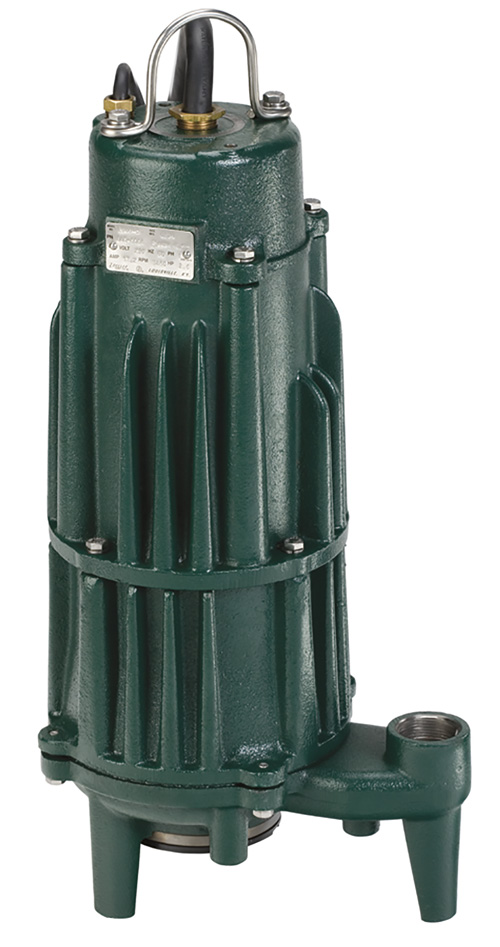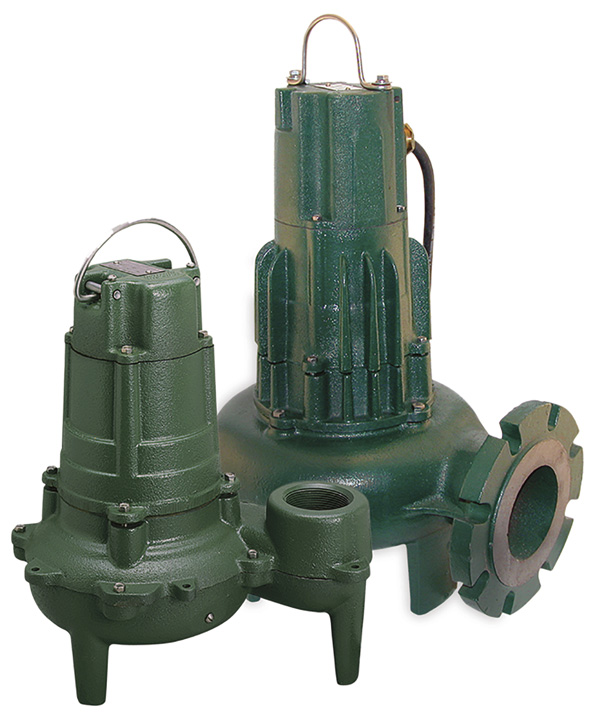Sewage pumps operate based on Daniel Bernoulli’s principles (Hydrodynamica, 1738), which define the effects of balanced energy on fluid systems. This equation employs kinetic pressure and potential energies that are required to move a matrix of solids and water through a conduit with specific properties. This movement must maintain a minimum velocity of 2 feet (61 centimeters) per second to prevent the buildup of solid scaling on the walls of the piping conduit
Contrary to popular belief, pumps do not create pressure. Pumps create flow, and restricting this flow, either within the confines of a pump or the boundaries of a pipe, results in pressure. As the areas that maintain the flow are changed through orifice sizes, clearances between parts and pipe diameters and lengths, the pressure, and flow rate reflect those changes.
Two types of sewage pumps are ejector/solids-handling pumps and grinder pumps. Ejector/solids-handling pumps use different mechanical and electrical methods to deliver wastewater and solids from one location to another. Different motors and impellers are used to develop flows, and different pump housings allow for the passage of different solid sizes. Impeller types include vortex, semi-open, closed, multi-vane and single vane.
The impeller is attached to the motor shaft and operates at different speeds, ranging from 600 to 3,450 rpm. The pump’s speed depends on the motor. Variable frequency drives are also used to control motor speeds. The motor operates the impeller, which provides energy to the liquid creating the flow and a vortex inside the pump housing. Centrifugal forces created by the impeller on the water deepen the vortex. The water and suspended solids are compressed against the walls of the pump housing. Once the water and solids mixture reaches the discharge opening, they exit the housing and enter the piping delivery system.
 Grinder pumps cut solids in wastewater by shearing waste into particles that mix with the water, creating a near-liquid slurry. (Images courtesy of Zoeller)
Grinder pumps cut solids in wastewater by shearing waste into particles that mix with the water, creating a near-liquid slurry. (Images courtesy of Zoeller)Grinder pumps operate similarly but have added mechanical components. In addition to the pump housing and impeller, grinder pumps have a mechanism that cuts the solid components of the wastewater by shearing or macerating waste solids into particles that mix with the water, creating a near-liquid called slurry. Grinder pumps allow for smaller-diameter pipes than traditional solids-handling pumps. Several grinders are available with different cutter, plate, rotor and stator configurations that provide different cutting efficiencies.
The application dictates which pump an end user should use. Installing the correct pump type is important for the best efficiency and longevity of the equipment installed.
Solids-Handling Pumps
Solids-handling pump components are designed so that the rotating parts do not intentionally contact the waste material. The goal is to maintain the solids size and discharge it as close to its original form as possible. This allows for fewer pump components and uses the velocity of the waste as scrubbing agents on the pipe. In the residential and commercial industries, solids-handling pump discharges typically range from 1.5 inches (38 millimeters) to 4 inches (102 millimeters).
The impeller type determines the pump’s efficiency, clog reduction, and wear and corrosion resistance. A semi-open impeller is the most efficient configuration and is suggested when radical solids and water quality problems are not factors. The impeller can be single or multi-vane and is designed for specific applications.
Semi-open impellers typically enter the flow path in the pump housing, which can potentially clog because of unusual solids entering the pump housing.
Vortex impellers are less efficient but have better clog resistance features. A vortex impeller is typically recessed in the upper part of the pump housing, which keeps it out of the wastewater flow path. These impellers are typically used for trailer parks, schools and public facilities where any type of waste may find its way into a lift station. Because of the reduced clogging potential, life-cycle costs for maintenance are lowered.
Water quality issues pose many concerns for submersible pumps. Water that has parameters outside typical raw domestic sewage may cause problems with submersible pumps, including corrosion and wear. Factors that may pose risks include high chlorine content, suspended granular particulates (sand or gravel), pH ranges outside the neutral 6 to 8 levels and hard water deposits. Combine these factors with impellers that turn at speeds up to 3,650 rpm, and the pump housing becomes a volatile environment. Other concerns for submersible pumps are impeller issues from cavitation, reduced inflow during operation, misapplied pump design and air locking.
Impeller designers can combat these issues. Water quality issues can be eliminated or minimized by using different materials of construction for impellers. Ductile iron is the most common and cost-effective material but has water quality limitations. Bronze and stainless steel are alternate materials used for chemical, abrasion and cavitation resistance. Fully understanding the application and involving the pump manufacturer early in the design process are important for ensuring that the right pump, impeller and materials are used to extend the life expectancy of the equipment.
Grinder Pumps
Grinder pumps are an excellent design for specific applications and environments. However, a grinder pump is not the answer to all solids applications. Flow rates and velocities are ultimately the deciding factors for pipe size in a force main application. Because grinder pumps reduce the solid size of sewage, smaller pipe diameters can be used. This slurry can then be transported through a piping conduit to a desired location. This use of smaller pipe makes it easier to install in tight locations.
 Sewage pumps have two types: ejector/solids-handling and grinder pumps. Different mechanical and electrical methods deliver wastewater and solids from one location to another.
Sewage pumps have two types: ejector/solids-handling and grinder pumps. Different mechanical and electrical methods deliver wastewater and solids from one location to another.Grinder pumps may be designed using the same type and construction of impellers as solids-handling pumps to deliver wastewater to or through cutter mechanisms. The impeller is used to develop the flow rate and suction, drawing the material through the cutting mechanism. Cutter components are typically made of hardened stainless steel to provide a sharp edge and extend the surface life of the steel cutter with which the wastewater contacts at all times.
Many types of grinder pumps are available for different applications. Raw domestic sewage is the least aggressive and least difficult application, and nearly all types of grinder pumps are useful in these applications.
Centrifugal grinder pumps are designed to handle kitchen and bathroom waste and other materials that cause clogging in typical solids-handling pumps. A progressive (or semi-positive displacement) grinder pump is another style that uses a hydraulic rotor and hydraulic stator, instead of an impeller, with a typical cutter mechanism. This pump type develops higher head capacities and is typically consistent with lower flow rates. Progressive grinders are used for applications in which the distance to a treatment plant or collection system is extremely long.
Dual-stage grinders use multiple impellers to perform the same task, but with a higher flow rate. This grinder pump is typically used in residential and light commercial applications.
Commercial or municipal waste can pose complications for residential grinder pumps. Commercial applications can produce stringy, fibrous and dense material that may jam a residential cutter assembly. Heavy-duty grinder pumps should always be considered for these applications.
In difficult applications, another type of grinder pump called a chopper pump can be used. This pump uses a series of rotating and stationary cutter plates that the waste passes through on its way to the impeller. This pump is used in prisons, schools and municipal applications where the material being pumped cannot be determined or if constant clogging or jamming events occur. A chopper pump is also the most expensive type grinder pump and typically passes larger solid sizes than residential grinder pumps.
The Right Selection
Choosing the right submersible pump for the application is critical. Life-cycle costs, energy costs and maintenance requirements should all be considered in the system design. Removing a solids-handling pump from an application and placing a grinder pump in its place must be considered carefully. Contact a pump professional for advice and recommendations to determine the correct pump for application.


